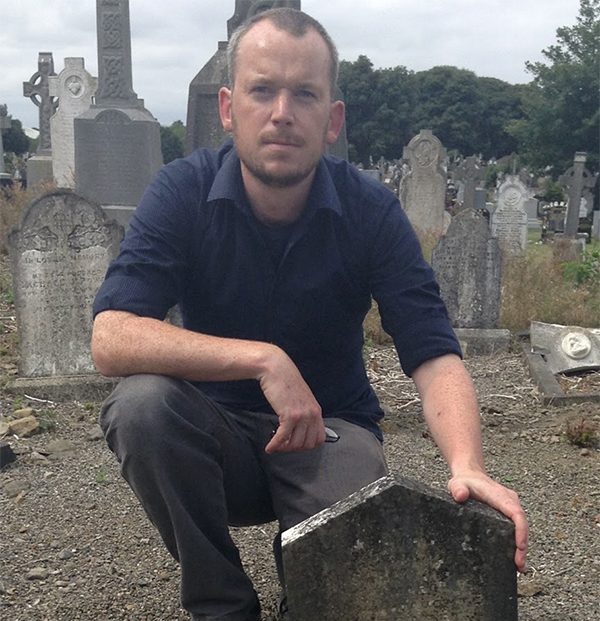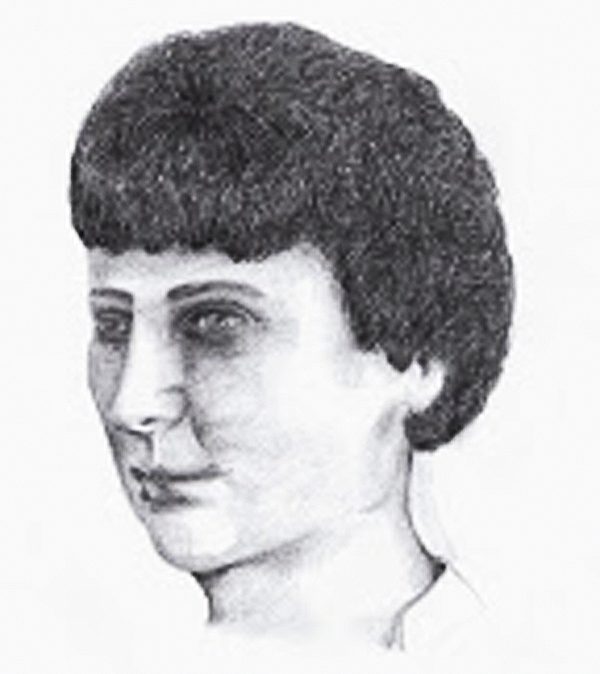
Pictured Above: Pádraig Óg Ó Ruairc pictured at Margaret Keogh’s graveside in Glasnevin Cemetery. Picture by Maria Shields O’Kelly.
In Glasnevin Cemetery, concealed behind the honoured tombstones of our past heroes, lies an unimposing, humble headstone with the inscription ‘Margaret Keogh, Died for Ireland.’
Who was this woman about whom there is so little known? She was a mere 19 years old when her life was cut short in the final hours of the War of Independence. Her life may have been brief but her contribution to the social and political landscape that made Irish independence attainable is undeniable.
Historian Pádraig Óg Ó Ruairc, PhD, is fascinated by her story, and his latest book – Truce: Murder, Myth and the Last Days of the War of Independence – looks into the circumstances of the Margaret Keogh Murder. Keogh lived at No.20 Stella Gardens, Irishtown and was the only surviving child of Patrick and Margaret senior.
Ó Ruairc told NewsFour, “If there was a person who could embody the politics of the Irish Revolution it was Margaret Keogh. She worked in a print firm in Dame Street and was a trade unionist. She was a member of Cumann na mBan and looked for the vote for women. She was an Irish speaker and member of Conradh na Gaeilge, the Irish language organisation, and this links to the only record of her being arrested. She refused to give her name in English when being questioned while fundraising for Conradh na Gaeilge.”
There is still much speculation surrounding her death. Why was she killed? Was it a revenge shooting for an IRA attack elsewhere? A case of mistaken identity? Or was it a case of one more shot at the enemy before the ceasefire could take effect?
Keogh died knowing that the war was over, adding poignancy to this tragedy. Through detective work and perseverance, Ó Ruairc has pieced together the details of this forgotten story, which was picked up on by Irishtown local Matt Ward. He and his wife Colette realised that the house in Stella Gardens was a stone’s throw away from their own residence and that despite living in the general area for generations, they had both been oblivious to its history until now.

Pictured: Sketch impression of Margaret Keogh.
Touched by the story, they invited Ó Ruairc to the scene of the tragedy at No.20 to talk about the possibility of having a suitable memorial erected in Keogh’s honour.
Ó Ruairc was glad to visit the scene at No. 20 and recounted the details of the story as he stood in the doorway. “People visit museums and castles to get a buzz about history but there is something really special about being on a street where an event took place.“
At 11.15pm on the night of July 10th 1921, Keogh heard a knock at the door of her family home. She went to answer, but when she opened the door she could see no one outside in the darkness. As she was closing the door she heard a single gunshot, and felt a sting in the side. She fell back in the hall mortally wounded.
She was rushed to Sir Patrick Dun’s hospital for treatment but died there the next day shortly after the ceasefire began. She managed to make a brief statement about the shooting but could not identify her attackers.
Press of the time reported that the British forces were conducting raids on republican houses at the time and had tried and failed to gain entry to the house beside Keogh’s. Sinn Féin councillor Joseph Curran lived a few doors away from Keogh’s and complained of suspicious and aggressive behaviour during the raids by the Worcester Regiment.
“The leader had two revolvers, and a cap pulled down over his eyes as a disguise, and behaved like a desperado, a Dick Turpin like character, terrorising women and children,” he said.
As Ó Ruairc looked towards the banks of the Dodder over the green area across from the house, they concluded how easy it would have been for Margaret’s assassin to slip away into the darkness, and wondered if the area has remained unchanged. Ward mentioned that her own grandmother would have lived there during Keogh’s time. “I have asked relations for information but apparently those who were there never talked about those troubled times. It was just too upsetting,” he added.
Ó Ruairc’s search for answers brought him to London, where he has gone through over 2,000 record files. “There is one file I can’t find; Margaret Keogh!”
He told us that the press of the time were allowed to report the existence of an inquiry but not its details. The official record is either hidden or destroyed. With the information available it is reasonable to deduce that Keogh was indeed the last victim of the illicit British ‘murder gangs’. She was a daughter, an activist, a patriot and the only woman who died for Ireland during that struggle. Forgotten, until now.
“Hopefully, this story will be shared throughout the community,” Ward told NewsFour. “It is a sad piece of history but one we should all be proud of. I am contacting local politicians about a memorial for our local hero who died for Ireland. Colette and myself will be taking a trip to Glasnevin cemetery to pay tribute to the brave young lady.”
‘Truce: Murder, Myth and the Last Days of the War of Independence,’ is available at Books on the Green, Sandymount and all good bookstores.
By Maria Shields O’Kelly



